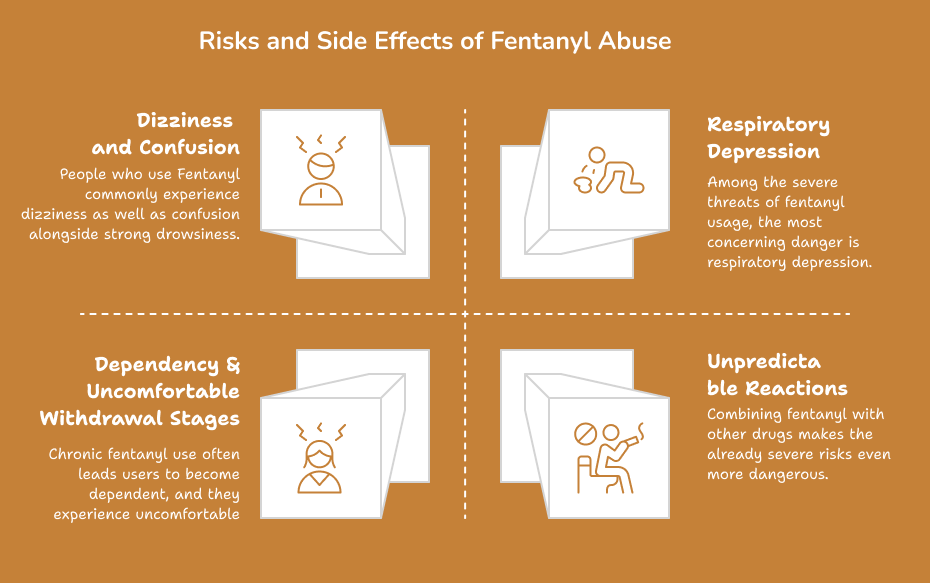The rising prominence of Fentanyl medication has become widespread over recent years because of its link to America’s ongoing opioid epidemic. Medical professionals utilize fentanyl because of its impressive properties, although the substance has become well-known due to deadly overdoses related to its addictive properties. This potent compound holds several unanswered questions regarding both its nature and its effects on human beings. Our research will reveal how users discuss this substance by using street names, which serve as hidden terminology. We will examine lawful medical applications of fentanyl as well as its dangerous addictive properties. The complete comprehension of these elements enables better management of this intricate matter. The complex narrative of fentanyl and its societal impact today awaits our investigation. The National Institute on Drug Abuse provides comprehensive Fentanyl Drug Facts for public understanding
Street Names for Fentanyl
The powerful opioid Fentanyl receives diverse names on the street. The specific terminology that people use for drugs fluctuates between geographical zones and separates distinct user communities. The term “China white” shows fentanyl’s origin, while “Tango & Cash” identifies specific drug combinations with Fentanyl. Users invent different names for this drug, either as “Apache” or “Fent.” Within communities heavily involved in fentanyl addiction, street names act as secret identifiers. People who use the terms can talk about their drug use without attracting unnecessary notice.
Knowledge about this street language allows us to identify how serious the current fentanyl addiction crisis has become. The data shows a general increase in fentanyl addiction across both urban and rural areas.
1. Apache
The street name delivers a comparison between Fentanyl’s intense potency with the Apache tribe’s fierce nature. The street drug markets use these names to mask their illegal substances. According to these slang terms, Fentanyl works like a surprise assault by triggering sudden, intense reactions. Common in urban drug slang.
2. China Girl / China White
People use this term to describe Fentanyl and high-quality heroin that originates from Southeast Asia. “A China Girl” serves as a street name to describe synthetic drugs originating mainly from Chinese manufacturing sites. When included with heroin, this substance raises the chances of overdosing. Drug culture carries this term as a prominent expression.
3. China Town
An altered take on “China White” points toward illegal Fentanyl manufacturing facilities. The drug appears to follow routes connecting users with hidden criminal networks involving illegal drugs. This term acts as a way to discuss the substance indirectly without mentioning its name directly. This particular term appears throughout both the American and international drug markets.
4. Dance Fever
Fentanyl produces euphoric and stimulating effects according to this term. Users of Fentanyl experience nodding or twitching because of its effects on the body. People use this term during encounters at parties and nightclub drug events. Fentanyl gets mistaken for a stimulant when it operates as a depressant.
5. Friend
The drug receives this seemingly contradictory moniker because Fentanyl can cause death despite providing relief from pain. People use this term to minimize the risks within the drug community environment. Individuals employ code words as protection against law enforcement while navigating drug markets. The false language used in drugs reveals their deceptive nature.
6. Goodfellas
A reference to the movie indicates that users or dealers share loyalty. These terms indicate the extreme addictive strength of this drug. People in certain areas use this term undercover to discuss the drug. Drug slang derived from popular culture demonstrates its influence.
7. Great Bear
People used the word “bear” to represent the drug’s powerful nature. This reference describes particular batches or brands that circulate in the illegal pharmaceutical market. Some regions maintain the use of this term even though it remains less frequently utilized. Use of this name creates a fantastical and threatening vibe.
8. He-Man
The pharmaceutical compound bears its name due to its high potency just like the well-known cartoon figure. The naming suggests extreme strength yet poses a deadly danger to its users. The drug’s marketing campaigns highlighted its extreme potency as a potent trip. Small doses of this substance bring a concealed warning about its deadly potential.
9. Jackpot
The term used to demonstrate obtaining powerful high experiences while endangering one’s life through dangerous consequences. Fentanyl receivers normally encounter this situation when other drugs combine with their Fentanyl mixture without their knowledge. Many overdose survivors do not survive the experience, which makes the term “grim.” The nature of Fentanyl use in the illegal market functions like Russian roulette.
10. King Ivory
This variant of “China White” uses noble and prestigious linguistic expressions to describe its sound. “Top-tier” signifies pure Fentanyl (sold with other drugs as a common practice). It serves in marketing promotions between dealers to attract clients. Misinformation exists since potencies between different samples can diverge wildly.
11. Murder 8
The number “8” possibly links to the eighth letter “H,” which connects the drug to heroin mixes. Certain regions consider this term both as an alert about potency and as a declaration of power. The drug world recognizes this name for its absolute truthfulness.
12. Tango & Cash
The drug combination carries the movie title as a code for its combination of Fentanyl with other substances. Baggies serve as a term to describe Fentanyl present in cocaine and heroin mixes. These names describe both a quick and extremely dangerous yet short-lived drug experience. A common reference in popular culture disguises a dangerous level of threat.
13. Cash
Relevant to the lucrative nature of Fentanyl sales, this name appears as an abbreviated expression. The term may also reflect its ability to give users quick cash payments because of how addictive Fentanyl can be. This euphemism helps drug dealers communicate undetected. The drug industry uses this direct word to describe how profitable their operations are.
Different regions employ unique names for drugs, which frequently alter to dodge detection by police forces. The threat arises from knowing how much Fentanyl has been mixed with the substance or whether other harmful substances (Carfentanil or Xylazine) exist within it. Do you need additional information about a particular term mentioned?
Medical Uses and Benefits of Fentanyl
Doctors prescribe Fentanyl as a synthetic opioid that serves medical purposes primarily. Doctors use fentanyl to treat intense pain while treating major surgery or to manage cancer patients undergoing long-term treatment.
The extreme strength of fentanyl makes it suitable for treating conditions that resist other painkillers. The small amounts required to treat pain make fentanyl an essential drug for treating patients who can endure substantial discomfort. Patients benefit from flexibility in administration because fentanyl exists in forms that include patches and injections, and lozenges.
Fentanyl provides healthcare providers with a fast-acting effect through its administration method. Patients benefit from fast symptom relief because they do not need to endure delayed pain relief that frequently accompanies other forms of analgesics. Fentanyl works through medical prescriptions under close healthcare provider oversight to treat debilitating pain, while being an essential medicine tool in modern practice.
The Rise of Fentanyl Addiction
Recent years have brought about a substantial increase in Fentanyl addiction, which changes the way substance abuse develops. Medical professionals originally employed fentanyl as a strong pain medication, but it has now become an uncontrollable illicit substance. Fentanyl’s affordability, together with its easy availability, has driven the surge in its use. Multiple people use fentanyl for their chronic pain and emotional issues while being unaware of the drug’s extreme potency.
Dealers now have easier access to mix fentanyl with other drugs because of the rise in synthetic opioids. Unaware drug users put their safety at risk when exposed to this dangerous drug mix. People avoid seeking addiction treatment options because of societal prejudice, which ultimately forces them to delay treatment until there is no choice left. The alarming surge in fatal fentanyl overdoses underlines the critical necessity for increased public understanding regarding this overdose epidemic. The escalating availability of fentanyl presents communities with previously unknown problems caused by widespread drug misuse.
On October 11, 2024, According to Oregon Health Authority and the Overdose Response Strategy issued an alert about re-emerging novel substances linked to increased fatal and non-fatal overdoses in Oregon and Southeast Washington.
Side Effects and Risks of Fentanyl Abuse
The dangers connected to fentanyl abuse develop rapidly into a severe condition. People who use fentanyl typically do not recognize its strength, which results in fatal overdoses. A small dosage of this substance is enough to kill someone. For a full overview of the drug’s effects and risks, refer to NIDA’s detailed information
1. Dizziness and Confusion
People who use Fentanyl commonly experience dizziness as well as confusion alongside strong drowsiness. Impaired judgment, together with diminished coordination, produces higher risks for accidents.
2. Respiratory Depression
Among the severe threats of fentanyl usage, the most concerning danger is respiratory depression. Receiving treatment within seconds becomes essential to save someone’s life because fentanyl use blocks or slows down breathing until death occurs.
3. Dependency & Uncomfortable Withdrawal Stages
Chronic fentanyl use often leads users to become dependent, and they experience uncomfortable withdrawal symptoms upon stopping the drug. Withdrawal attempts cause strong cravings and create anxiety or irritability in individuals who use fentanyl. For a deeper understanding of just how addictive fentanyl can be, including specific risks and symptoms of dependence, explore our comprehensive guide.
4. Unpredictable Reactions
Combining fentanyl with other drugs makes the already severe risks even more dangerous. When mixed, these substances generate unpredictable reactions that increase the risk of overdose and potentially fatal outcomes.

Addiction Treatment Options for Fentanyl Users
1. Medical Interventions
Medical interventions play a vital role in fentanyl addiction treatment since they come in different treatment modalities. A large number of people gain advantages from medication-assisted treatment (MAT) that features buprenorphine or methadone as its core components. The medications serve to reduce withdrawal symptoms and manage cravings.
2. Counseling
Treatment recovery relies heavily on counseling as an active component. Behavioral therapies give important help through their focus on treating the psychological part of addiction. Group therapy allows users to form a support network by sharing recovery experiences among members of the community.
3. Inpatient Rehabilitation Treatment Programs
Focusing solely on recovery takes place in inpatient rehabilitation treatment programs because they remove patients from their regular environments where triggers may prevail. Clients who participate in outpatient programs gain both freedom and structured guidelines.
4. Support Groups
Support groups offer continuous encouragement to individuals throughout the period following their official treatments. Different recovery methods demonstrate the need for tailor-made healthcare solutions to achieve sustainable breakthroughs against substance dependence.
Conclusion
The effects of fentanyl upon society demonstrate multiple complex dimensions. The potent synthetic opioid has reshaped pain management by delivering substantial advantages to people who need it. The increasing improper utilization of fentanyl reveals a major public health emergency.
Addiction remains a formidable challenge. Regular struggles with dependence lead numerous people to endure serious, destructive outcomes. The growing number of deaths from fentanyl exposure emphasizes the necessity to teach people about this drug. The public needs to understand fentanyl’s complicated nature and its street drug names so that they can develop effective treatment strategies and prevention tactics in the future.
What is the most common street name for Fentanyl?
People refer to Fentanyl by different street names such as “China White,” “Apache,” “Tango & Cash,” and “Murder 8.” Forty-three different street names exist for Fentanyl throughout different regions across the United States to provide a disguise for this drug in illicit markets. China White started as a reference to heroin, but people now use it interchangeably with Fentanyl because of its identical features and strength.
Why is Fentanyl called “Murder 8”?
People call Fentanyl Murder 8 because its overdose danger is so severe that experts consider it comparable to murder. The number eight may reference the eighth letter, H, in the alphabet, which represents heroin hybridization with this drug. Murder 8 pertains to the severe danger of this medication that becomes deadly in situations where users unknowingly consume it.
Are Fentanyl street names the same everywhere?
Different regions across the nation use different street names for Fentanyl which evolve regularly so law enforcement struggles to stay ahead of its detections. The street name “China Girl” dominates American markets but other markets tend to use “Great Bear” or “King Ivory.” New street language develops regularly among dealers who want to stay undetected by law enforcement.


